Product Info Summary
| SKU: | M00143 |
|---|---|
| Size: | 100 μg/vial |
| Reactive Species: | Human, Mouse, Rat |
| Host: | Mouse |
| Application: | Flow Cytometry, IF, IHC, ICC, WB |
Customers Who Bought This Also Bought
Product info
Product Name
Anti-CA2 Antibody Picoband® (monoclonal, 10E11)
View all Carbonic Anhydrase II/CA2 Antibodies
SKU/Catalog Number
M00143
Size
100 μg/vial
Form
Lyophilized
Description
Boster Bio Anti-CA2 Antibody Picoband® (monoclonal, 10E11) catalog # M00143. Tested in Flow Cytometry, IF, IHC, ICC, WB applications. This antibody reacts with Human, Mouse, Rat. The brand Picoband indicates this is a premium antibody that guarantees superior quality, high affinity, and strong signals with minimal background in Western blot applications. Only our best-performing antibodies are designated as Picoband, ensuring unmatched performance.
Storage & Handling
Store at -20˚C for one year from date of receipt. After reconstitution, at 4˚C for one month. It can also be aliquotted and stored frozen at -20˚C for six months. Avoid repeated freeze-thaw cycles.
Cite This Product
Anti-CA2 Antibody Picoband® (monoclonal, 10E11) (Boster Biological Technology, Pleasanton CA, USA, Catalog # M00143)
Host
Mouse
Contents
Each vial contains 4mg Trehalose, 0.9mg NaCl, 0.2mg Na2HPO4, 0.05mg NaN3.
Clonality
Monoclonal
Clone Number
10E11
Isotype
Mouse IgG2b
Immunogen
E.coli-derived human CA2 recombinant protein (Position: S2-K260). Human CA2 shares 81.1% and 80.7% amino acid (aa) sequence identity with mouse and rat CA2, respectively.
*Blocking peptide can be purchased. Costs vary based on immunogen length. Contact us for pricing.
Cross-reactivity
No cross-reactivity with other proteins.
Reactive Species
M00143 is reactive to CA2 in Human, Mouse, Rat
Reconstitution
Add 0.2ml of distilled water will yield a concentration of 500μg/ml.
Observed Molecular Weight
28 kDa
Calculated molecular weight
46659 MW
Background of Carbonic Anhydrase II/CA2
CA2 is a cytosolic enzyme with the highest activity among all known CAs. The carbonic anhydrases (ACs) form a family of enzymes that catalyze the rapid interconversion of carbon dioxide and water to bicarbonate and protons (or vice versa), a reversible reaction that occurs relatively slowly in the absence of a catalyst. Mutations in the CA2 gene result in the CA II deficiency syndrome, an autosomal recessive disorder that produces osteopetrosis, renal tubular acidosis and cerebral calcification. This gene is mapped to 8q22.
Antibody Validation
Boster validates all antibodies on WB, IHC, ICC, Immunofluorescence, and ELISA with known positive control and negative samples to ensure specificity and high affinity, including thorough antibody incubations.
Application & Images
Applications
M00143 is guaranteed for Flow Cytometry, IF, IHC, ICC, WB Boster Guarantee
Assay Dilutions Recommendation
The recommendations below provide a starting point for assay optimization. The actual working concentration varies and should be decided by the user.
Western blot, 0.1-0.5μg/ml
Immunohistochemistry (Paraffin-embedded Section), 0.5-1μg/ml
Immunocytochemistry/Immunofluorescence, 5μg/ml
Flow Cytometry (Fixed), 1-3μg/1x106 cells
Positive Control
WB: rat heart tissue, rat kidney tissue, rat spleen tissue, rat liver tissue, mouse heart tissue, mouse kidney tissue, mouse spleen tissue, mouse liver tissue, human placenta tissue, human 293T whole cell
IHC: human gastric cancer tissue, human colon cancer tissue, mouse intestine tissue, rat intestine tissue
ICC/IF: HEPG2 cell
FCM: 293T cell
Validation Images & Assay Conditions
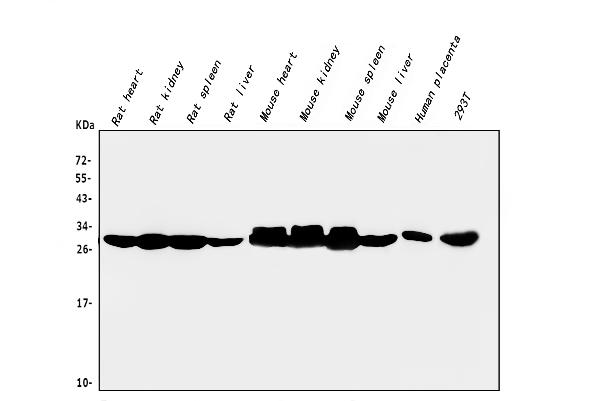
Click image to see more details
Figure 1. Western blot analysis of CA2 using anti-CA2 antibody (M00143).
Electrophoresis was performed on a 5-20% SDS-PAGE gel at 70V (Stacking gel) / 90V (Resolving gel) for 2-3 hours. The sample well of each lane was loaded with 50ug of sample under reducing conditions.
Lane 1: rat heart tissue lysates,
Lane 2: rat kidney tissue lysates,
Lane 3: rat spleen tissue lysates,
Lane 4: rat liver tissue lysates,
Lane 5: mouse heart tissue lysates,
Lane 6: mouse kidney tissue lysates,
Lane 7: mouse spleen tissue lysates,
Lane 8: mouse liver tissue lysates,
Lane 9: human placenta tissue lysates,
Lane 10: human 293T whole cell lysates.
After Electrophoresis, proteins were transferred to a Nitrocellulose membrane at 150mA for 50-90 minutes. Blocked the membrane with 5% Non-fat Milk/ TBS for 1.5 hour at RT. The membrane was incubated with mouse anti-CA2 antigen affinity purified monoclonal antibody (Catalog # M00143) at 0.5 μg/mL overnight at 4°C, then washed with TBS-0.1%Tween 3 times with 5 minutes each and probed with a goat anti-mouse IgG-HRP secondary antibody at a dilution of 1:10000 for 1.5 hour at RT. The signal is developed using an Enhanced Chemiluminescent detection (ECL) kit (Catalog # EK1001) with Tanon 5200 system. A specific band was detected for CA2 at approximately 28KD. The expected band size for CA2 is at 28KD.
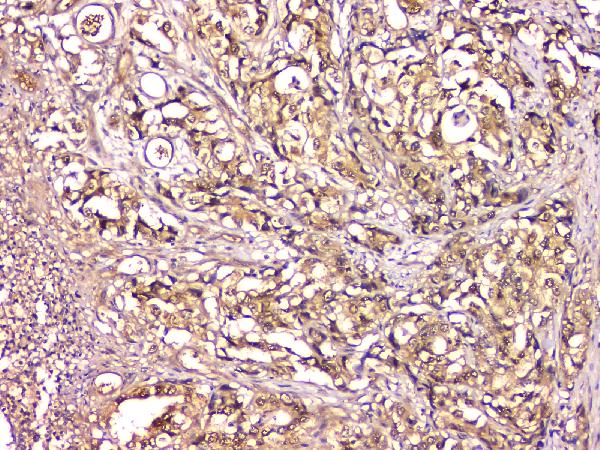
Click image to see more details
Figure 2. IHC analysis of CA2 using anti-CA2 antibody (M00143).
CA2 was detected in paraffin-embedded section of human gastric cancer tissue. Heat mediated antigen retrieval was performed in EDTA buffer (pH8.0, epitope retrieval solution). The tissue section was blocked with 10% goat serum. The tissue section was then incubated with 1μg/ml mouse anti-CA2 Antibody (M00143) overnight at 4°C. Biotinylated goat anti-mouse IgG was used as secondary antibody and incubated for 30 minutes at 37°C. The tissue section was developed using Strepavidin-Biotin-Complex (SABC) (Catalog # SA1021) with DAB as the chromogen.
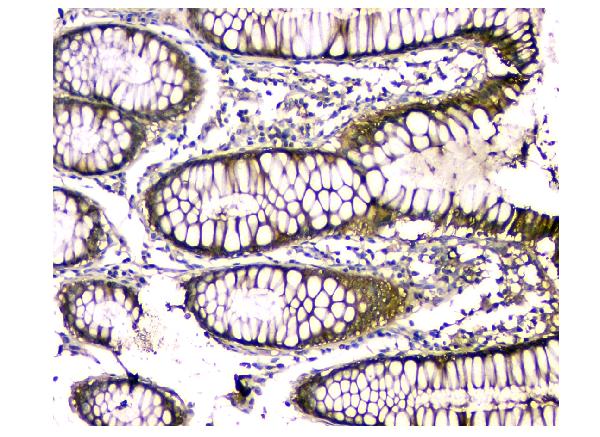
Click image to see more details
Figure 3. IHC analysis of CA2 using anti-CA2 antibody (M00143).
CA2 was detected in paraffin-embedded section of human colon cancer tissue. Heat mediated antigen retrieval was performed in EDTA buffer (pH8.0, epitope retrieval solution). The tissue section was blocked with 10% goat serum. The tissue section was then incubated with 1μg/ml mouse anti-CA2 Antibody (M00143) overnight at 4°C. Biotinylated goat anti-mouse IgG was used as secondary antibody and incubated for 30 minutes at 37°C. The tissue section was developed using Strepavidin-Biotin-Complex (SABC) (Catalog # SA1021) with DAB as the chromogen.
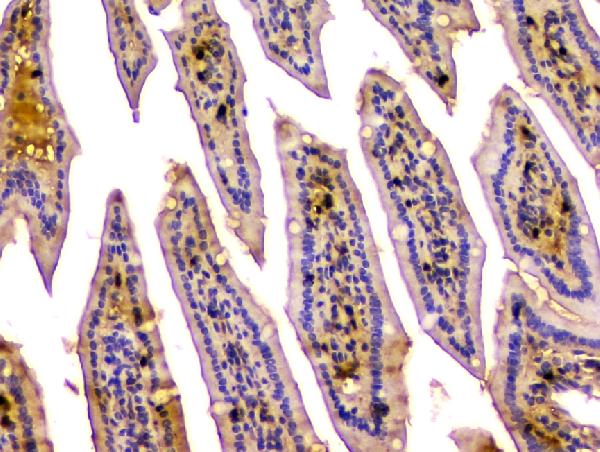
Click image to see more details
Figure 4. IHC analysis of CA2 using anti-CA2 antibody (M00143).
CA2 was detected in paraffin-embedded section of mouse intestine tissue. Heat mediated antigen retrieval was performed in EDTA buffer (pH8.0, epitope retrieval solution). The tissue section was blocked with 10% goat serum. The tissue section was then incubated with 1μg/ml mouse anti-CA2 Antibody (M00143) overnight at 4°C. Biotinylated goat anti-mouse IgG was used as secondary antibody and incubated for 30 minutes at 37°C. The tissue section was developed using Strepavidin-Biotin-Complex (SABC) (Catalog # SA1021) with DAB as the chromogen.
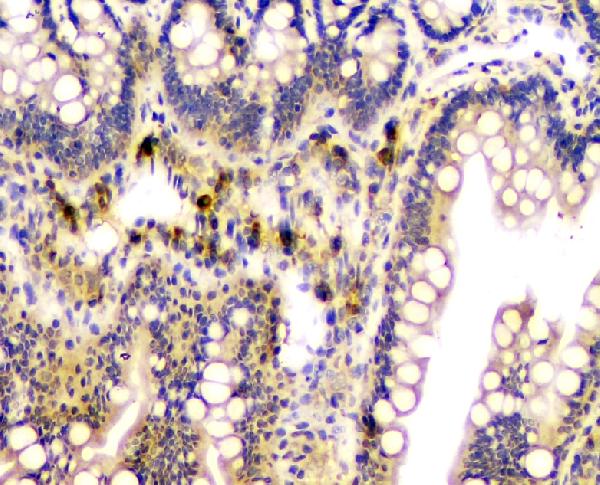
Click image to see more details
Figure 5. IHC analysis of CA2 using anti-CA2 antibody (M00143).
CA2 was detected in paraffin-embedded section of rat intestine tissue. Heat mediated antigen retrieval was performed in EDTA buffer (pH8.0, epitope retrieval solution). The tissue section was blocked with 10% goat serum. The tissue section was then incubated with 1μg/ml mouse anti-CA2 Antibody (M00143) overnight at 4°C. Biotinylated goat anti-mouse IgG was used as secondary antibody and incubated for 30 minutes at 37°C. The tissue section was developed using Strepavidin-Biotin-Complex (SABC) (Catalog # SA1021) with DAB as the chromogen.
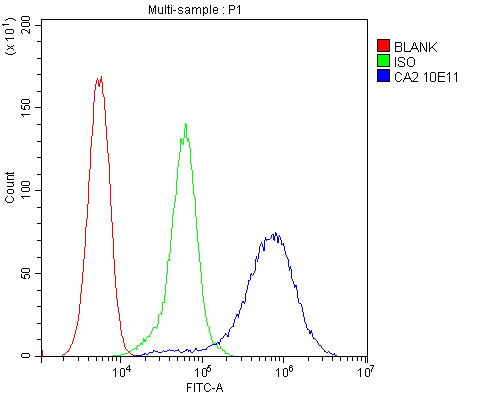
Click image to see more details
Figure 6. Flow Cytometry analysis of 293T cells using anti-CA2 antibody (M00143).
Overlay histogram showing 293T cells stained with M00143 (Blue line). To facilitate intracellular staining, cells were fixed with 4% paraformaldehyde and permeabilized with permeabilization buffer. The cells were blocked with 10% normal goat serum. And then incubated with mouse anti-CA2 Antibody (M00143, 1μg/1x106 cells) for 30 min at 20°C. DyLight®488 conjugated goat anti-mouse IgG (BA1126, 5-10μg/1x106 cells) was used as secondary antibody for 30 minutes at 20°C. Isotype control antibody (Green line) was mouse IgG (1μg/1x106) used under the same conditions. Unlabelled sample (Red line) was also used as a control.
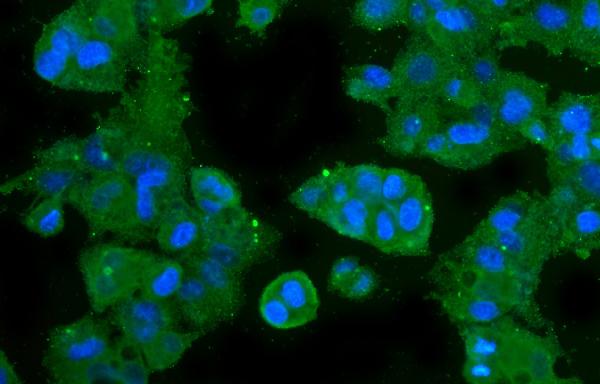
Click image to see more details
Figure 7. IF analysis of CA2 using anti-CA2 antibody (M00143).
CA2 was detected in immunocytochemical section of HEPG2 cells. Enzyme antigen retrieval was performed using IHC enzyme antigen retrieval reagent (AR0022) for 15 mins. The cells were blocked with 10% goat serum. And then incubated with 5μg/mL mouse anti-CA2 Antibody (M00143) overnight at 4°C. DyLight®488 Conjugated Goat Anti-Mouse IgG (BA1126) was used as secondary antibody at 1:100 dilution and incubated for 30 minutes at 37°C. The section was counterstained with DAPI. Visualize using a fluorescence microscope and filter sets appropriate for the label used.
Protein Target Info & Infographic
Gene/Protein Information For CA2 (Source: Uniprot.org, NCBI)
Gene Name
CA2
Full Name
Carbonic anhydrase 2
Weight
46659 MW
Superfamily
alpha-carbonic anhydrase family
Alternative Names
Carbonic anhydrase 2; Carbonate dehydratase II; Carbonic anhydrase C; CAC; Carbonic anhydrase II; CA-II; CA2 CA2 CA-II, CAC, CAII, Car2, HEL-76, HEL-S-282 carbonic anhydrase 2 carbonic anhydrase 2|carbonate dehydratase II|carbonic anhydrase B|carbonic anhydrase C|carbonic anhydrase II|carbonic dehydratase|epididymis luminal protein 76|epididymis secretory protein Li 282
*If product is indicated to react with multiple species, protein info is based on the gene entry specified above in "Species".For more info on CA2, check out the CA2 Infographic

We have 30,000+ of these available, one for each gene! Check them out.
In this infographic, you will see the following information for CA2: database IDs, superfamily, protein function, synonyms, molecular weight, chromosomal locations, tissues of expression, subcellular locations, post-translational modifications, and related diseases, research areas & pathways. If you want to see more information included, or would like to contribute to it and be acknowledged, please contact [email protected].
Specific Publications For Anti-CA2 Antibody Picoband® (monoclonal, 10E11) (M00143)
Hello CJ!
M00143 has been cited in 1 publications:
*The publications in this section are manually curated by our staff scientists. They may differ from Bioz's machine gathered results. Both are accurate. If you find a publication citing this product but is missing from this list, please let us know we will issue you a thank-you coupon.
Calcium-and integrin-binding protein-1 and calcineurin are upregulated in the right atrial myocardium of patients with atrial fibrillation
Recommended Resources
Here are featured tools and databases that you might find useful.
- Boster's Pathways Library
- Protein Databases
- Bioscience Research Protocol Resources
- Data Processing & Analysis Software
- Photo Editing Software
- Scientific Literature Resources
- Research Paper Management Tools
- Molecular Biology Software
- Primer Design Tools
- Bioinformatics Tools
- Phylogenetic Tree Analysis
Customer Reviews
Have you used Anti-CA2 Antibody Picoband® (monoclonal, 10E11)?
Submit a review and receive an Amazon gift card.
- $30 for a review with an image
0 Reviews For Anti-CA2 Antibody Picoband® (monoclonal, 10E11)
Customer Q&As
Have a question?
Find answers in Q&As, reviews.
Can't find your answer?
Submit your question
6 Customer Q&As for Anti-CA2 Antibody Picoband® (monoclonal, 10E11)
Question
Would anti-CA2 antibody (monoclonal, 10E11) M00143 work on zebrafish IHC-P with urinary bladder?
Verified Customer
Verified customer
Asked: 2019-12-19
Answer
Our lab technicians have not validated anti-CA2 antibody (monoclonal, 10E11) M00143 on zebrafish. You can run a BLAST between zebrafish and the immunogen sequence of anti-CA2 antibody (monoclonal, 10E11) M00143 to see if they may cross-react. If the sequence homology is close, then you can perform a pilot test. Keep in mind that since we have not validated zebrafish samples, this use of the antibody is not covered by our guarantee. However we have an innovator award program that if you test this antibody and show it works in zebrafish urinary bladder in IHC-P, you can get your next antibody for free.
Boster Scientific Support
Answered: 2019-12-19
Question
We want to test anti-CA2 antibody (monoclonal, 10E11) M00143 on rat urinary bladder for research purposes, then I may be interested in using anti-CA2 antibody (monoclonal, 10E11) M00143 for diagnostic purposes as well. Is the antibody suitable for diagnostic purposes?
C. Jones
Verified customer
Asked: 2019-10-25
Answer
The products we sell, including anti-CA2 antibody (monoclonal, 10E11) M00143, are only intended for research use. They would not be suitable for use in diagnostic work. If you have the means to develop a product into diagnostic use, and are interested in collaborating with us and develop our product into an IVD product, please contact us for more discussions.
Boster Scientific Support
Answered: 2019-10-25
Question
See attached the WB image, lot number and protocol we used for urinary bladder using anti-CA2 antibody (monoclonal, 10E11) M00143. Please let me know if you require anything else.
E. Li
Verified customer
Asked: 2019-10-10
Answer
Thank you very much for the data. Our lab team are working to resolve this as quickly as possible, and we appreciate your patience and understanding! You have provided everything we needed. Please let me know if there is anything you need in the meantime.
Boster Scientific Support
Answered: 2019-10-10
Question
Would M00143 anti-CA2 antibody (monoclonal, 10E11) work on parafin embedded sections? If so, which fixation method do you recommend we use (PFA, paraformaldehyde, other)?
J. Jackson
Verified customer
Asked: 2019-08-16
Answer
It shows on the product datasheet, M00143 anti-CA2 antibody (monoclonal, 10E11) as been validated on WB. It is best to use PFA for fixation because it has better tissue penetration ability. PFA needs to be prepared fresh before use. Long term stored PFA turns into formalin, as the PFA molecules congregate and become formalin.
Boster Scientific Support
Answered: 2019-08-16
Question
Thanks for helping with my inquiry over the phone. Here are the WB image, lot number and protocol we used for urinary bladder using anti-CA2 antibody (monoclonal, 10E11) M00143. Let me know if you need anything else.
Verified Customer
Verified customer
Asked: 2019-07-09
Answer
We appreciate the data. You have provided everything we needed. Our lab team are working to resolve your inquiry as quickly as possible, and we appreciate your patience and understanding! Please let me know if there is anything you need in the meantime.
Boster Scientific Support
Answered: 2019-07-09
Question
Is this M00143 anti-CA2 antibody (monoclonal, 10E11) reactive to the isotypes of CA2?
D. Krishna
Verified customer
Asked: 2015-06-05
Answer
The immunogen of M00143 anti-CA2 antibody (monoclonal, 10E11) is E.coli-derived human CA2 recombinant protein (Position: S2-K260). Human CA2 shares 81.1% and 80.7% amino acid (aa) sequence identity with mouse and rat CA2, respectively. Could you tell me which isotype you are interested in so I can help see if the immunogen is part of this isotype?
Boster Scientific Support
Answered: 2015-06-05





